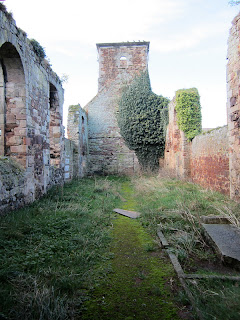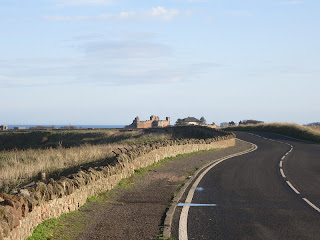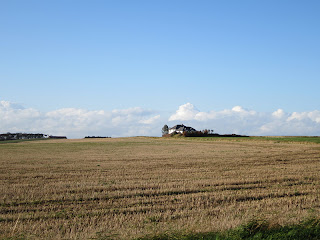I started the escapade in the early morning. My intention was to get to North Berwick and the castle by no later than 11 and get back to the train station by 2 so that I can get back to St. Andrew's with time to spare to be productive in academics. I guess you could call what I was doing was educational. I left for Leuchars train station where I caught the train to Waverely Station where I would connect to another train that would take me to North Berwick. I had no issues. Surprisingly, in all of my travels, I have never had a problem with travel that did not work out or give me the better option.
I arrived in North Berwick but had no idea where to go. I was told to find the tourist building. I had no idea so I walked towards the large clock tower in the direction I thought I should go. Sure enough I started to see signs for what I needed to find (I never have a map). I decided to stop for some breakfast in a little shop. I got a sandwich and some tea. I was fueled and ready to go. I found the tourist building, but unbeknownst to me, it was closed until April. Really dumb, so I had no way to find out where Tantallon was or how to get there. I walked two blocks to the beach where I saw a sea bird preservation building thing. The guy inside told me the bus station I wanted was right by the tourist place, but it would be an hour before the bus would arrive. So I had two options: I could wait an hour and take a 5 minute bus ride to Tantallon or walk 40 minutes along the coast to the castle. Either way, my timing was going to be off anyway. I decided to walk. It was a pleasantly warm day and sunny. I had no issues walking. I was told what road to follow and just keep walking, so that is what I did. I did veer off but a nice man helped me get me to where I needed to go. I was not far off. If I followed my gut I would have been right. So all in all, the walk to me about an hour, but that was with me stopping to see the ocean, cliffs, and various things on the path. It was a very nice walk (3 miles approx.) Once I got close enough, you could see Tantallon rise up in the distance, very similar to Dunnottar Castle a few weeks earlier. The pictures below are of my journey to the castle and the things that I saw.
I thought North Berwick looked a lot like St. Andrew's. The resemblance with the beach and the clock tower is astonishing
Some cool ruined church inside a graveyard. I love ruins
Path that went through the woods
Finally on my way. I would follow this for quite sometime. You can see Tantallon in the middle in the distance a ways off.
Bass Rock: if you look closely you can see two really cool things. One is on the rock. Its a lighthouse. The second thing is just to the left. It's hard to see but its a navy battle cruiser that was patrolling the harbor. Pretty cool.
So pretty
Everything in the vicinity was flat, except for this large mound in the distance. Strange?
The sidewalk disappeared, so I walked along the farm field so I would not get hit by a car
Tantallon Castle = Glorious
When I was arriving, two large buses of students and old people were leaving, which meant that I would be able to explore the castle for the most part with no other people to get in the way. I strolled slowly and looked at the outside for quite sometime so they would all leave.
Two disclaimers: First, if you are afraid of heights, tiny places, narrow and uneven staircases etc... exploring castles might not be for you. I enjoy it immensely. Secondly, I am writing this post the day that I did my presentation of the castle, so I will attempt to be educational.
This is the family crest of William the first earl of Douglas. He was made an earl in 1358. This was very significant, for this was only the 3rd earldom created since the 12th century. The crest is the 'bludy heart' which stands for the heart of Robert the Bruce. The Douglas family were crucial to the war effort. The family is a dynasty of warriors for the Scottish cause. Through their support of Robert Bruce, they gained land and power after the Wars with England.
In 1354, William Douglas came into possession of his father and his uncle 'Good Sir James Douglas' (good friend of Robert the Bruce. In celebration of his newfound wealth and status, William constructed mighty Tantallon castle. This was a conscious decision to look back at the golden age of castle building (13th century) in both its scale and magnitude. The defining feature of that age was the use of immense curtain walls. Tantallon is known to be the last great curtain wall castle built in Scotland. After this time is when Tower House and artillery fortifications become the typical construction of castles. Tantallon was indeed a visible statement of power and authority in Southern Scotland and "offers the most memorable images of power of the late medieval magnate."
In the 1380's the Douglas family split into the factions of red and black. Earl William married Margaret the sister of the Earl of Mar and gave birth to James. He also took a mistress, also named Margaret who was the Countess of Angus (brother in laws widow), who birthed George. Both William and his rightful heir James died within 4 years of each other. The senior line passed to the illegitimate son (cousin) Archibald the Black or 'Grim.' He was a very unpleasant looking man with many battle scars (not partially good at winning battles, but could muster large numbers of men). He was said to wield a sword that no other man could lift. So an imposing man. The junior line passed to George who became the Earl of Angus after his mother resigned her earldom to him. The Red Douglas's retained Tantallon.
Tantallon survived two full scale sieges and was destroyed on the last. The first in 1491 occurred when the 5th earl of Angus entered into a treasonable pact with Henry VII of England. Not much happened in the siege. The second was in 1528. In 1514, Archibald 6th earl of Angus, Married James IV widow, Margaret Tudor. James the V (future king of Scotland) was born 2 years prior. It was agreed that both families would raise James. When it came time, Archibald did not give up James and locked him in Edinburgh castle. In 1528 James escaped and charged Archibald with treason starting a 20 day siege. The castle was not taken. The last siege occurred in 1651 under Cromwell's invasion of Scotland. Essentially what is seen of the castle was a result of that siege. Cromwell's cannons wrecked havoc on the castle destroying it.
The use of raised grassy banks made it difficult to use siege engines or get close enough to the wall to cause any serious damage
Gate into the outer close of the castle. Used to be an arch doorway.
Guntower: built prior to the 1528 siege to increase security on the gate into the outer close. Was later inserted with gun holes to protect the gate
East Tower: home to senior officials and guests of Tantallon castle. After 1528 the lower half of the tower was outfitted into a suitable gun defense. On the 3rd floor is evidence for barred window. It is believed that the Duchess of Albany 1425 and MacDonald Lord of the Isles 1429 were held in this chamber as prisoner, but were not kept in the prison for they had status.
The Mid Tower or gatehouse has the most significant improvements to the castles outer face. Orginally the entrance was set between two large towers. In the 1400's a barbican was added in front of the greenish rounded slab, and was set to increase security. The greenish section is called the Fore Tower and was added after 1556 to increase the walls resistance to impacts of cannon shot. The greenish stone is a softer stone called green basalt. The rest of the castle was built using a local red sandstone. Therefore the Mid-Tower sticks out from the rest of the castle. The tower was also home to the Constable.
The curtain wall is the most imposing element of Tantallon. The walls are 50 feet high, 12 feet thick, and 300 feet long (cliff to cliff). The walls were built with the intention of resisting stone throwing siege equipment not cannons, which is why it could never be upgraded into a artillery fortress.
The Douglas Tower was the main residence for the Lord and Lady in the castle. However it only survives as a fragment of what it once was. Originally over 100 feet tall, we can assume that the size, name, and layout and relation to the hall support this being the main residence. However not much is known about the accommodation since it was destroyed in 1651.
Closer view of Bass Rock
Douglas Tower
Mid Tower: Portal was really small. It was originally only large enough to accommodate a small cart and was made smaller to 1 person at a time. So quite small and easy to defend.
Inside the Mid Tower
Inside the Inner close looking at the Mid Tower
The Great Hall
View from the ramparts
Douglas Tower from the Top. And yes, there was no rail
East Tower
Sadly, after the siege of 1651, the castle was abandoned. The accommodation was demolished but the castles purpose of being a fortress was no longer evident. The castle showed itself to be outdated and could not serve its purpose for it could not be an artillery fort. When it was constructed it was to resist earlier siege equipment and was also designed to impress. The Castle was left to the birds but has been nicely restored to some extent. I was thoroughly impressed with my experience. It was a blast, and a very picturesque castle. One that I will remember always.







































No comments:
Post a Comment